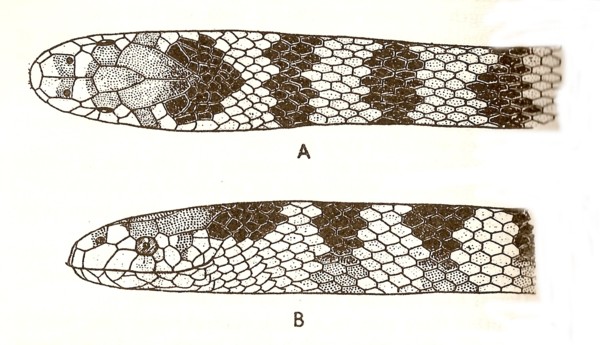[ITIS|ID=700227|taxon="Hydrophis"|year=2007|date=7 September] ]Description
Head moderate; eye shorter than its distance from the mouth in the adult. Rostral slightly more broad than deep; nasals shorter than the frontal, more than twice as long as the suture between the praefrontals; praefrontals usually in contact with the second upper labial; frontal more long than broad, as long as its distance from the rostral or the tip of the snout; one prae- and two postoculars; two superposed anterior temporals; seven or eight upper labials, third, fourth and usually fifth entering the eye or divided; both pairs of chin-shields in contact or posterior separated by one scale. Body long; scales sub-imbricate, keeled or with two or three tubercles, in 39-45 rows (27 33 anteriorly); ventrals 281-385, smooth or with two or more tubercles. Greenish-olive above, with blackish or olive transverse bars or annuli, broadest on the back, sometimes connected by a black band along the belly; or yellowish, with a black vertebral band and a few black bars on the neck. Length of head and body 1360 mm.; tail 140 mm. [Rooij, Nelly de. 1915. The reptiles of the Indo-Australian archipelago. Leiden.]
Distribution
Found in the Indian Ocean (From the Persian Gulf, Iran, Pakistan, India, Sri Lanka, Bangladesh, Myanmar, Thailand, Malaysia, Philippines: Visayan Sea, Panay etc.) and the marine waters around Korea, Japan, Solomon Islands, South China sea (incl. Hainan), East China Sea (incl. Taiwan), Coastal regions of Shandong and Liaoning (China) Coasts of Persian Gulf (Oman, United Arab Emirates), east through South Asia until New Guinea.
References
Bibliography
* Bussarawitt,S.; Rasmussen, A.R. & Andersen, M. 1989 A preliminary study on sea snakes (Hydrophiidae) from Phuket Harbor, Phuket Island, Thailand. Nat. Hist. Bull. Siam Soc., Bangkok 37 (2): 209-225
* Murray,J.A. 1887 Three New Species of Hydrophis. J. Bombay Nat. Hist. Soc. 2: 32-35
External links
*

